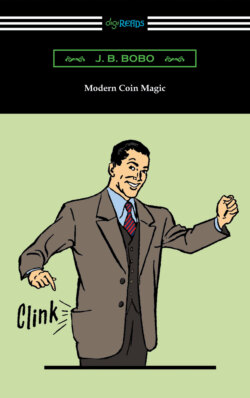Читать книгу Modern Coin Magic - J. B. Bobo - Страница 41
На сайте Литреса книга снята с продажи.
THE ILLUSIVE COIN PASS
ОглавлениеT. J. CRAWFORD in Greater Magic
This sleight was given the above title by John Northern Hilliard when he was preparing for T. Nelson Downs that magical classic, The Art of Magic, as the coin pass had been submitted to him without a name.
The pass is not one automatically acquired immediately after reading the instructions, but performers who have mastered it have found the effort to perfect it time well spent. It enables the performer to completely vanish a coin from the hand in which it was unmistakably placed. The spectator actually sees the coin lying in the palm of the left hand, yet when the hand is opened, the coin has apparently melted away. Nor is it limited to one coin. Several coins may be vanished singly.
The Method: The coins are picked up from the table, a coin rack, or from the palm of a spectator’s extended hand. With the sleeves up and the hands empty, the performer takes one coin between the thumb and index finger of the right hand, holding the coin as near the edge as possible. This scanty grip on the edge is important, as all the surface of the coin possible should be exposed and well polished coins should be used. Much of the effect is psychological and these details are helpful.
What actually happens is this: the coin is really placed in the palm of the left hand and, for a brief interval, the spectators see it lying there, but it is never released from the grip of the thumb and finger on its extreme edge. Strange as it may seem, this fact does not dawn on the spectator. To his eye the coin has either melted away or gone into a mysterious pocket in the palm of the left hand.
The timing at this stage is the vital element. The instant the coin is shown openly in the left palm, Fig. 1, the fingers of that hand begin to close over it, and when they have closed to the point of screening the coin from view, the middle, third and little fingers of the right hand are extended full length under the curved fingers of the left, Fig. 2. The three right hand fingers form a screen for the coin as the right hand moves away with it. Without this screen, there would be a ruinous flash of the bright coin, which is still held in its original position by the thumb and index finger, Fig. 3.
As the left hand is slowly closed and extended, and the eyes of the assembly are focused on that point, the fingers of the right hand are pushing the coin to a center palm. A momentary pause allows the situation to be absorbed, then follows the deliberate process of opening the left hand, showing back and front, with fingers wide apart. The coin is gone. And likewise, several coins are vanished one after the other.
The stack of coins in the left hand can be produced in a fan and showered into a glass after both hands have been shown empty by the change over palm, or transferred to the fork-of-thumb palm (See The Downs Palm, page 25), and after both palms have been seen empty, reproduced from the air one at a time.
As a vanish for a single coin, this is one of the best, and is only equaled by a similar vanish by that modern master of subtlety, Dai Vernon, which is simply titled A Coin Vanish.
